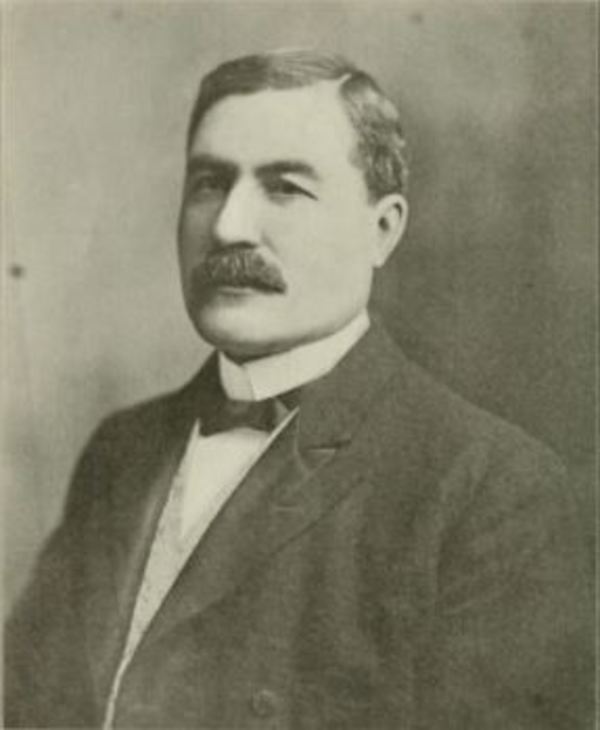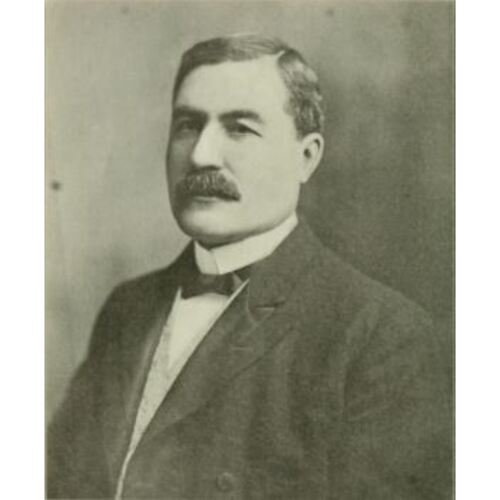
Source: Link
MABEE, JAMES PITT, lawyer, judge, and railway commissioner; b. 5 Nov. 1859 in Port Rowan, Upper Canada, son of Simon Pitt Mabee and Frances Susannah Leaton; m. there 24 Oct. 1883 Mary Soleby Thorold (d. 1910), and they had a daughter and a son; d. 6 May 1912 in Toronto.
A descendant of loyalist settlers in the Long Point region on Lake Erie, James P. Mabee was raised in Port Rowan, where his father was a justice of the peace, court clerk, and insurance agent. James attended St Thomas High School and then pursued studies at the University of Toronto and Osgoode Hall which led to his call to the bar in Michaelmas term 1882. That year the enterprising Mabee compiled for publication a series of lectures by Joseph Easton MacDougall on torts and negligence. Mabee supplemented the text with selected case references and introduced the work with the hope that it would assist students preparing for “the Intermediate and Final Examinations.”
Mabee began his legal career in Listowel. After five years he moved to Stratford, where, in partnerships, he developed an extensive practice and a reputation as a jury lawyer. He was appointed a qc in 1899 and elected a bencher of the Law Society of Upper Canada in 1904. Politically a Liberal, he served as a president of both the Stratford Liberal Club and the North Perth Reform Association; in the federal election of November 1904 he ran unsuccessfully against Alexander Ferguson MacLaren.
Mabee subsequently moved to Toronto, where he practised for about ten months with Beatty, Blackstock, Fasken, and Riddell. During this period, on 7 Jan. 1905, the federal government of Sir Wilfrid Laurier named him first chairman of the Canadian section of the International Waterways Commission, formed to resolve problems over boundary waters. He soon stepped down – to be succeeded by George Christie Gibbons – as a result of his appointment on 18 November to the chancery division of Ontario’s High Court of Justice, in place of Richard Martin Meredith*. Mabee’s selection was well received by the Canadian Law Times (Toronto), which found him “without fads or prejudices.”
For some two and a half years Mabee served alongside such prominent members of the bench as Chancellor Sir John Alexander Boyd and Chief Justice William Glenholme Falconbridge, whose forceful abilities may actually have constrained Mabee’s development as a judge. In decisions his opinions frequently coincided with those of senior colleagues. To the extent that his own views were apparent, he showed a strong preference for active judicial supervision of municipal authority, as in Re Rickey and the Corporation of the Township of Marlborough (1907), where the issue was a lax exercise of by-laws.
On 24 March 1908 Mabee received a new assignment, to succeed Albert Clements Killam* as full-time head of the Board of Railway Commissioners, a federal body that, in the estimate of the Canada Law Journal (Toronto), possibly possessed “wider powers than any Court in Canada.” Even without the duties resulting from Mabee’s additional appointment, in 1910, as Canada’s representative in negotiations for the joint control of traffic rates between Canada and the United States, his workload was onerous. Since 1906, in addition to railway operations, express, telegraph, and telephone companies had been under the jurisdiction of the board, which held hearings frequently all across Canada; by 1912 it would have 65 permanent staff. Never deterred by legal technicality or corporate bullishness, Mabee was ideally qualified to meet the challenges of an evolving regulatory process. As one observer noted, “He whipped lawyers and witnesses into line, brushed away the pettifoggeries, and let it be known that, while the law is a fearful and wonderful thing, justice is very simple and a matter of few words.”
During Mabee’s four years as chief commissioner, the board handled a complex series of major rate disputes in changing economic circumstances. Of particular significance was the Regina Board of Trade case (1909–10), where the ruling undermined a regional freight-rate structure that had favoured merchants in Manitoba. In Dawson Board of Trade v. White Pass and Yukon Railway Company (1912) Mabee demonstrated a concern for the security of capital invested by operators, but he did so in the context of the well-being of the national economy. In a significant ruling in 1911 he had also used the protection of capital to justify monopolistic control. While trying to be fair in a dispute in Ontario between Bell Telephone and a group of independent telephone companies, he supported Bell’s control of long-distance lines, thus insulating Bell from even marginal competition. “The exploitation of competing lines in towns and cities,” Mabee reasoned, “is simply a waste of capital and a cause of irritation in municipalities where duplicate lines exist.”
Mabee generally dealt judiciously with the railways, the board’s main concern. On occasion he was careful to safeguard the competitive position of Canada’s railway network from the adverse impact of general policy, such as sabbath observance under the Lord’s Day Act of 1906. At the same time he was emphatic in numerous cases on the need for safety, at crossings for instance, and was unwilling to allow carriers to impose unauthorized charges on shipping clients whose survival often depended on the predictability associated with published tariffs.
Mabee’s leadership of the railway commission ended abruptly when he was stricken with appendicitis at a board hearing in Toronto on 29 April 1912. After an operation, gangrene set in and he died in hospital on 6 May; he was buried in the Anglican cemetery at Port Rowan. Summing up his years as chief commissioner, the Canada Law Journal stated that “his administration . . . was marked by a masterly grasp of the situation followed by a prompt and intelligent decision which, as a rule, carried conviction, by its wisdom and righteousness, even to those whose claims were refused or modified.” Newspaper editorials, eulogies, and even cartoons stressed Mabee’s fairness, popularity, and leadership in the regulatory supervision of transportation and communications in Canada.
Although additional appointments to the board during his chairmanship contributed to the pattern of drawing upon senior counsel and members of the bench, Mabee’s tenure may be seen, in the light of his previous experience with the International Waterways Commission, as a pioneering development in the making of career commissioners.
J. E. MacDougall’s Law lectures: subjects: torts and negligence, delivered before the law students of Toronto, at Osgoode Hall, reported and published by J. P. Mabee, was issued in Toronto in 1882.
AO, RG 80-5-0-118, no.7952; RG 80-8-0-387, no.1921. NA, MG 30, E94. World (Toronto), 7–8 May 1912. Jamie Benidickson, “The Canadian Board of Railway Commissioners: regulation, policy and legal process at the turn-of-the-century,” McGill Law Journal (Montreal), 36 (1991): 1222–81. Can., Parl., Sessional papers, 1914, no.20c: 98. Canada Gazette, 11 Feb. 1905: 1643; 2 Dec. 1905: 1127; 28 March 1908: 2568; 11 June 1910: 3863. Canada Law Journal (Toronto), 44 (1908): 169–73; 48 (1912): 313–14. Canadian annual rev. (Hopkins), 1909: 616; 1910: 619–21; 1911: 634–35. Canadian Law Rev. (Toronto), 4 (1905): 551. Canadian Law Times (Toronto), 25 (1905): 722. Canadian men and women of the time (Morgan; 1912). Canadian Railway Cases (Toronto), vols.7–13 (1908–12). Directory, Toronto, 1879–1910. Re Rickey and the Corporation of the Township of Marlborough (1907), Ontario Law Reports (Toronto), 14: 587–94. C. P. Stacey, Canada and the age of conflict: a history of Canadian external policies (2v., Toronto, 1977–81), 1: 108–9.
Cite This Article
Jamie Benidickson, “MABEE, JAMES PITT,” in Dictionary of Canadian Biography, vol. 14, University of Toronto/Université Laval, 2003–, accessed January 10, 2026, https://www.biographi.ca/en/bio/mabee_james_pitt_14E.html.
The citation above shows the format for footnotes and endnotes according to the Chicago manual of style (16th edition). Information to be used in other citation formats:
| Permalink: | https://www.biographi.ca/en/bio/mabee_james_pitt_14E.html |
| Author of Article: | Jamie Benidickson |
| Title of Article: | MABEE, JAMES PITT |
| Publication Name: | Dictionary of Canadian Biography, vol. 14 |
| Publisher: | University of Toronto/Université Laval |
| Year of publication: | 1998 |
| Year of revision: | 1998 |
| Access Date: | January 10, 2026 |



